- Thelonious Monk’s Harmony, Rhythm, and pianism (Part 3)
- Read Part 1 here and Part 2 here.
- Rhythm and Pianism
- Rhythm
- Pianism
- Analysis of Two Peers
- Find and download Thelonious Monk’s sheet music transcriptions in our Library.
- Thelonious Monk With John Coltrane (1961) (Full Album)
Thelonious Monk’s Harmony, Rhythm, and pianism (Part 3)
Read Part 1 here and Part 2 here.
Rhythm and Pianism
Rhythm
The rhythmic traits for which jazz is known and at which it excels—groove, swing, speed, heat, cool, polyrhythm, conversational interaction among players, dense and irregular improvised motives and phrases, antiphonal call and response, and more—are all but absent in ISC. Most modern jazz group performance emphasizes strict periodicity with terrific forward momentum created by players’ rhythmically propulsive contributions. Formidable mastery, poise, and virtuosity are needed to play.
Tempi are characteristically either fast enough to scare off would-be pretenders, or, just as daringly, cooled off to an unruffled “ballad” speed, and steady in either case. The metric backbone is the succession of harmonies with the beat usually actualized and propelled by the walking quarter notes of the bass and the drums’ “ride” cymbal. Though harmonies change on measure downbeats and sometimes middles, the beats in between—beats and in a four-beat measure—are stressed to create a driving backbeat.
Solo performances and recordings are almost exclusively the provenance of pianists, who could use the left hand to simulate the roles of the rhythm section, with either walking bass lines or the evocation of earlier styles such as stride or boogie-woogie. Monk himself made extensive use of these latter techniques on his own solo records, as well as on the unaccompanied numbers that were generally included in his live sets. Solo performers such as Art Tatum would also “extemporize,” straying from steady time in introductions, quasi-cadenzas, and so on. For Monk, though, a solo ballad like ISC was an opportunity to stretch time in a far more radical manner, eschewing steady time almost completely.
Swing, an idiomatic variation of the timing of the subdivided beat, depends on underlying regularity. It involves a dynamic relationship between measured periodicity and the realm of unmeasured music, rhythmic freedom that can be implied through soloists’ styles. This dynamism in turn references a melodic vernacular—the sense that a soloist is “speaking through their horn.” Some would argue that this has to do with the lyricism of the human voice, others that it represents some kind of middle ground between a discursive, rhetorical European way of making music and a more interactive, poly-rhythmic African approach. Others might say that both are true or that it simply feels good, and that, having been discovered and developed at the turn of the twentieth century, it proved irresistible.
Monk’s ISC can be said to swing only in the colloquial sense of being compellingly musical, that is, simply because he is saying something in a distinctive way. But strictly understood, swing can exist only against a conception of steady time, and in this recording nothing keeps time.
Except fleetingly in a few spots, it is impossible to move the body in any regular pulsation to Monk’s playing. He is clearly not keeping steady time internally—or else he has a very different clock. If we listen intently for the regularity most bodies crave—and which we expect from familiarity with more standard versions of the song—we must jolt in and out of time with him. The slow regular beat of the tune’s harmonic progression remains impassively present, a law both obeyed and mocked. Monk often played solo ballads in this manner, a meditation with outbursts, with an affect both reverent and ironic. In live performance with a group, this number would be surrounded by tunes that swung hard. In other words ISC’s rubato is heard—and is meant to be heard—in terms of the absence of jazz’s most authentic rhythmic traits, and of Monk’s abandonment of them in the service of other qualities.
Pianism
One of the most ergonomic inventions in human history, the piano and its eighty-eight-key action are among jazz’s essential European legacies. Its technology has empowered musical cultures as distant as Burmese and African American to adapt it to their own idioms, extending out from the panoply of European approaches to the instrument on completely unforeseen trajectories. Jazz piano’s trajectories crisscross and meld into a great tradition of their own.
No one gains entrance into the pantheon of jazz pianism without a strongly identifiable voice on the instrument. The differences among pianists are bread and butter to jazz lovers, from earlier era virtuosi like Jelly Roll Morton, James P. Johnson, Fats Waller, Earl Hines, and Art Tatum through beboppers like Bud Powell and Mary Lou Williams and on to a diversity of post-bop players far too numerous to cite or describe. But, as we have said, even among these names Monk comes in at a different angle due to a tightly bound combination of pianistic idiosyncrasies, harmony, and rhythm.
Yet we cannot properly appreciate these elements outside the context of what his peers developed for the instrument.
Keyboard concept, technique, and historical currents conspire to shape pianists’ approaches. All pianists have to consider multiple aesthetic issues determining what kinds of textures to favor in developing a style.
Individual tunes suggest their own approaches, but players develop idioms that carry over from tune to tune. Voicings can be played with from one to ten fingers—or sometimes, in Monk’s case, with flattened palms. Overall motion can be dense or sparse. The hands can be independent or interdependent. One can move freely around the entire keyboard or stay closer to its more conventional, “vocal” center. Nuances of touch, phrasing, and dynamic are essential.
Piano styles also group historically. The “orchestral” ways of playing that developed in jazz’s first few decades were strongly influenced by brass band marches and ragtime, and by the fact that before World War II jazz was primarily dance music. Pianists of those years tended to provide a clear beat and full harmonic support. Some, like bandleader Count Basie, favored economy of notes and texture. In contrast, there was nothing in piano technique or harmony that Art Tatum could not execute astonishingly, nor did he hesitate to infuse most everything he played with the encyclopedia of approaches at his disposal, in all kinds of combinations and throughout the entire range of the keyboard.
Bebop was for listening, not dancing, and its speed an excuse for cutting—that is, outplaying and stumping cohorts. The competition nudged piano technique to become lighter, fleeter, and sparser. The walking bass and drums safeguarded the time so pianists needed to do less in that regard, and the bass register was to some degree forsaken. Bud Powell’s style often rested on a chassis of insistent, rhythmically irregular, somewhat grating left-hand “shells” (the root of the chord played in the bass register, plus the seventh directly above it). Jutting from below, they cut in under single-line right-hand melodies that looped around the upper two-thirds of the keyboard, equaling Charlie Parker’s saxophone lines in their density and irregular phrasing.
In the 50s, jazz cooled off, tributaries of eclectic styles blossomed, and it became necessary to know how to play in many ways. Red Garland could imitate the fast-moving close harmonies of big band saxophone sections in passages featuring thick, parallel, two-handed chords moving with melodic gestures. Wynton Kelly emphasized idiomatic blues riffs. Influences of Cuban and Brazilian styles, and of modern European composition, gradually took root. But in the main, Powell’s saxophone-like approach to the right hand prevailed, while in the left hand many developed harmonically richer voicings, deployed somewhat like Powell’s shells.
Analysis of Two Peers
Compare figure 4.4’s transcriptions of the opening of I Should Care as played by Oscar Peterson and Bill Evans, two strikingly different but equally iconic pianists of the time. Peterson, stylistic and technical heir to Tatum, plays solo here with mid-range voicings of up to eight notes, some with left-hand shells, most containing all triad tones and the seventh. As mentioned earlier, he doubles the harmonic rhythm to quarter-note speed, which allows interpolation of tritone substitution dominants preparing the V and the I chords of mm. 1-2. The Eb7 at m. 1, beat 4 is voiced with a pungent #9 in addition to the seventh chord itself. Peterson exploits the hidden presence of an F# major triad within this sonority, playing it with the right hand to separate it from the Eb major triad
Figure 4.4a. Opening measures of Oscar Peterson’s version of I Should Care (transposed to D from the original key of Bb). From Soul-O!; Oscar Peterson, solo piano.
Figure 4.4b. Opening measures of Bill Evans’s version of I Should Care (transposed to D from the original key of C). From How My Heart Sings!; Bill Evans, piano, Chuck Israels, bass, and Paul Motian, drums.
Figure 4.4a and 4.4b
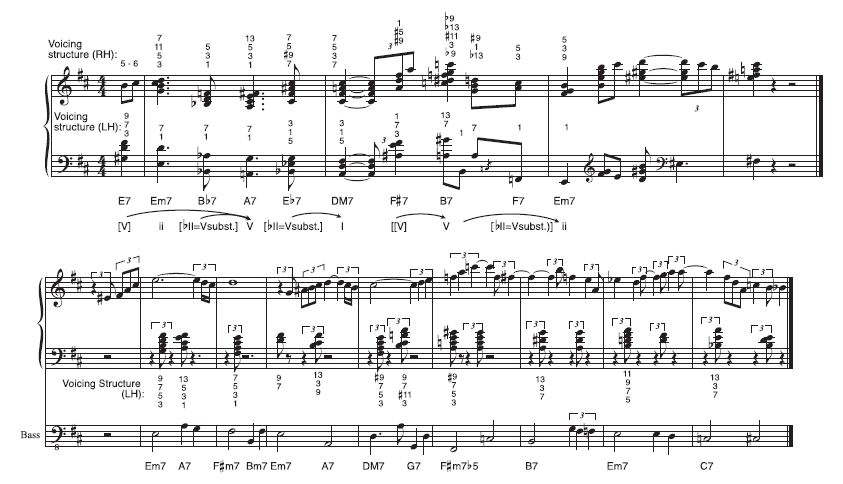
he places in the left. The left-hand triad then slides down in parallel motion to the downbeat of m. 2, but in the right the A# moves to A while the other tones remain in place. This reveals an F# minor triad comprising the third, fifth, and seventh of the DM7. The superpositions of triads and impeccable voice leading of this chord change are of a special richness in this region of the keyboard.
Shooting up in register, the F#7 chord on the second triplet eighth of m. 2, beat V is V of the B7 chord on beat 3, itself an applied V to the Em7 of m. 3. The F#7 is notable for its #9 (A) and the #5 (D), which is perhaps there only because Peterson has omitted the fifth of the chord (C# ; see also figure 4.3, middle column and second row under “Chromatic Tones”). On the next beat, where he brings the melody to a local peak, the fifth (F#) is again omitted, but both thirteenth (G#) and b thirteenth (G) are included. This B7, voiced with the root as an afterbeat, contains additional extension tones C and F that, combined with the others, conceal G# major, F major, C minor, and A diminished triads all at once. This sequence of lavish chords, texturally full and smooth, steady and propelled in rhythm and with a legato touch, give ISC sumptuous treatment.
Evans’s bass player Chuck Israels provides all the chord roots in metrically secure positions, so rather than double them or their rhythm, the pianist parries them with the left hand, playing deft offbeat rhythmic punches that converse polyrhythmically with the right hand’s intricate embellishment of the melody. Beyond this, however, Evan’s chord structures are similar to, albeit thinner than, Peterson’s. He remains in the piano’s central register, and he is equally fastidious about voice leading: the majority of the chord-to-chord connections proceed by step.
The elegantly contoured right-hand line begins by hugging the original tune, but transforms it completely after m. 4 (while still brushing the original C, B, and A in mm. 5-7). Evans sometimes uses melody to enrich the voicings, as when A–F# –D (thirteenth, #eleventh, ninth) is heard over the C7 chord in m. 8. He also gingerly clashes with them by using avoid tones, as with the F (#7) over the F#7b5 in m. 4, or the Eb similarly related to its Em7 harmony two measures later (see figure 4.3, left column and top row under “Chromatic Tones”). In both cases, though, Evans is careful to promptly lead by step to a more consonant resolution: the former moves up to F# at the end of the measure, while the latter goes directly down to D.
As we take up analysis of Monk’s ISC, we will find that features creating continuity in these two short excerpts—stepwise motion, propulsive rhythm, mid-range voicing, and a consistent level of density and dissonance—are missing. Monk did not by any means invent the notion of favoring discontinuities in these parameters. He did not come from nowhere, and it is well established that his style is part of a lineage extending from before Duke Ellington, through Monk, and on to later figures like avantgardist Cecil Taylor, not to mention the many who deliberately emulated Monk in recent decades. To hear those connections is a project for another time that would enable a crucial historical and stylistic narrative. But to frame Monk against the prevailing, more conventionally tasteful modern jazz aesthetics illustrated by figure 4.4 is to hear him at his most inimitable and strange.

Find and download Thelonious Monk’s sheet music transcriptions in our Library.
Thelonious Monk With John Coltrane (1961) (Full Album)
Browse in the Library:
| Artist or Composer / Score name | Cover | List of Contents |
|---|---|---|
| The Tom And Jerry Show – Hiromi Uehara (Piano Solo Sheet Music) (Musescore File).mscz | ||
| The Tommy Flanagan Collection |
 |
The Tommy Flanagan Collection |
| The Truman show – Dreaming Of Fiji – Philip Glass |
 |
|
| The Truman show – Reunion – Philip Glass | ||
| The Truman show – Truman Sleeps – Philip Glass | Truman sleeps | |
| The Trumanshow – Dreaming Of Fiji – Philip Glass | ||
| The Trumanshow – Truman Sleeps – Philip Glass | ||
| The Ultimate Fake Book 2nd Edition for keyboard, vocal, guitar and all C inst. |
 |
The Ultimate Fake Book 2nd Edition for keyboard, vocal, guitar and all C inst |
| The Ultimate Gospel Choir Book Vol4 |
 |
The Ultimate Gospel Choir Book Vol4 |
| The Ultimate Pop Rock Fake Book A-Z (ebook) |
 |
The Ultimate Pop Rock Fake Book A-Z (ebook) |
| The Ultimate Pop Rock Fake Book Joel Withburn |
 |
The Ultimate Pop Rock Fake Book Joel Withburn |
| The Untouchables – Main Title – Morricone (Musescore File).mscz | ||
| The Used – Smother Me | ||
| The Utimate Broadway Fake Book |
 |
The Utimate Broadway Fake Book – Hal Leonard |
| The Very Best Of John Williams – Dan Coates arr. easy piano |
 |
The Very Best Of John Williams – Dan Coates arr. easy piano |
| The Very Best Pop Songs Of All Time 19 of the best-ever pop songs Piano voica and guitar chords |
 |
The Very Best Pop Songs Of All Time |
| The Village – The Gravel Road – James Newton Howard | ||
| The Visible And Invisible In Pianoforte Technique (By Tobias Matthay) (1947) |
 |
|
| The way we were – Barbara Streisand | The way we were – Barbara Streisand | |
| The Way We Were – Piano And Vocal (Musescore File).mscz | ||
| The Way We Were – Piano and vocal Barbra Streisand | The Way We Were – Piano and vocal | |
| The Way We Were (Lead sheet with Guitar chrods and lyrics ) |
 |
|
| The Way We Were (Lead Sheet With Lyrics ) (Musescore File).mscz | ||
| The Way We Were (Musescore File).mscz | ||
| The Wedding Night (Frankenstein OST) Patrick Doyle | ||
| THE WHO – The Who Anthology |
 |
The Who Anthology Contents |
| The Who – Guitar Play Along Volume 108 WITH mp3 audio tracks with Tablature |
 |
Guitar Play-Along Volume 108 – The Who |
| The Who – Tommy (Piano-Vocal-Guitar) |
 |
The Who – Tommy |
| The Who Rockscore |
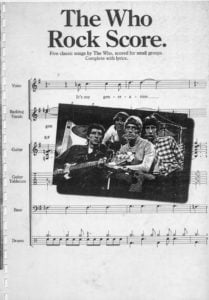 |
|
| The Who The Acoustic Guitar Collection Guitar Songbook TABs |
 |
The Who The Acoustic Guitar Collection Guitar Songbook TABs contents |
| The Who The Definitive Collection Volume A E Guitar TABs Songbook |
 |
The Who The Definitive Collection Volume A E Guitar TABs Songbook |
| The winner takes it all (Abba) | ||
| The Wizard of Oz – (Harold Arlen) Vocal & piano score |
 |
The Wizard of Oz – (Harold Arlen) -vocal.piano.score |
| The Wizard Of Oz The Musical by Andrew lloyd Webber |
 |
The Wizard Of Oz Musical Webber |
| The Wonder of Life (Afterwards OST) Alexandre Desplat | ||
| The Wonders – That Thing You Do | ||
| The Words And Music Of Frank Zappa By Kelly Fisher Lowe (Book) |
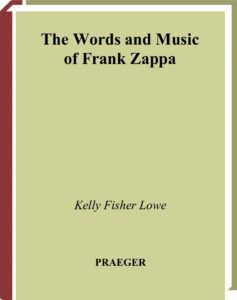 |
|
| The World Hits Of Oldies (Jazz Fake book) |
 |
|
| The World’s best music (Famous Compositions for Piano Vol. 1) 1904 | The world’s best music | |
| The World’s best music V Famous compositions for the piano |
 |
The World’s best music V Famous compositions for the piano |
| The World’s Greatest Fake Book |
 |
Greatest Fake Book |
| The Worlds best music I Famous compositions for the piano |
 |
The Worlds best music I Famous compositions for the piano |
| The Yellow Rose Of Texas – Traditional (Musescore File).mscz | ||
| The Young Pianist’s Anthology Of Modern Music (1972) |
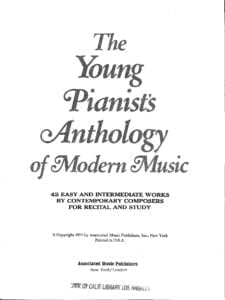 |
The Young Pianist’s Anthology Of Modern Music (1972) |
| The Zombies Songbook |
 |
|
| Thegogos – Head Over Heels | ||
| Thelonious Monk Compositions (as recorded by himself) | Thelonious Monk’s Compositions Fake Book – (Jazz) | |
| Thelonious Monk Blue Sphere |
 |
|
| Thelonious Monk easy piano solos Jazz |
 |
Thelonious Monk easy piano |
| Thelonious Monk – Japanese Folk song (Kojo No Tsuki) (sheet music transcription) |
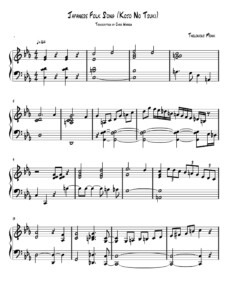 |
|
| Thelonious Monk – Jazz Masters |
 |
Thelonious Monk – Jazz Masters |
| Thelonious Monk – Originals and standards |
 |
Thelonius Monk originals |
| Thelonious Monk – The Man I Love (solo) Gershwin |
 |
|
| Thelonious Monk & Cootie Williams – ‘Round Midnight | Thelonious Monk & Cootie Williams – ’round Midnight | |
| Thelonious Monk Collection | Thelonius Monk Collection | |
| Thelonious Monk Collection 12 Note For Note Solo Piano Transcriptions Artist Piano Transcriptions |
 |
Thelonious Monk Collection 12 Note For Note Solo Piano Transcriptions Artist Piano Transcriptions |
| Thelonious Monk Compositions (as recorded by himself) | Thelonious Monk’s Compositions Fake Book – (Jazz) | |
| Thelonious Monk Fake Book | Thelonious Monk Fake Book | |
| Thelonious Monk Fake Book C Edition |
 |
Thelonious Monk Fake Book C Edition |
| Thelonious Monk For Guitar with TABs |
 |
Thelonious Monk For Guitar |
| Thelonious Monk Intermediate Piano Solos Arranged By Ronnie Mathews 14 Arrangements |
 |
Thelonious Monk Intermediate Piano Solos Arranged By Ronnie Mathews 14 Arrangements |
| Thelonious Monk Jazz Piano Collection |
 |
Thelonious Monk Jazz Piano Collection |
| Thelonious Monk Jazz Piano Solos Series Volume 49 |
 |
Thelonious Monk Jazz Piano Solos Series Volume 49 |
| Thelonious Monk Omnibook for piano Transcribed exactly from his recorded solos |
 |
Thelonious Monk Omnibook for piano Transcribed exactly from his recorded solos |
| Thelonious Monk Plays Standards – Volume 1 Artist Transcriptions Piano 12 transcriptions |
 |
Thelonious Monk Plays Standards – Volume 1 Artist Transcriptions Piano 12 transcriptions |
| Thelonious Monk Plays Standards – Volume 2 Artist Transcriptions Piano 12 transcriptions |
 |
Thelonious Monk Plays Standards – Volume 2 Artist Transcriptions Piano 12 transcriptions |
| Thelonious Monk Quartet featuring John Coltrane at Carnegie Hall (Book) |
 |
|
| Thelonious Monk Revealing Instincts Of The Genius Of Jazz Piano Originals |
 |
Thelonious Monk The Genius Of Jazz |
| Thelonious Monk Round Midnight Jazz Standard arr. Carsten Gerlitz |
 |
|
| Thelonious Monk Solo Transcriptions |
 |
Thelonious Monk Solo Transcriptions |
| Thelonious Monk Tea For Two (piano solo transcription sheet music, partition) | Thelonious Monk Tea For Two (piano solo transcription sheet music, partition) | |
| Thelonius Monk – Monk’s Music and Jazz History in the making (Book) |
 |
|
| Thelonius Monk – Thelonious transcription | Thelonius Monk – Thelonious transcription | |
| Theme de Charles (Un homme et son chien OST) Philippe Rombi | ||
| Thème de Jeanne – Le Diable par la Queue OST (Georges Delerue) | ||
| Thème de Jeanne – Le Diable par la Queue OST (Georges Delerue) trio version | ||
| Theme de Suzanne – Potiche OST (Philippe Rombi) | ||
| Theme from the Mermaid Chair (Secret Garden) | ||
| Theme From The Simpsons Jazz Play Along (Musescore File).mscz | ||
| Theodore Shapiro Diary Of A Wimpy Kid – Main Titles |
 |
|
| Theodore Shapiro Louder Than Thunder The Devil Wears Prada Theme Piano Solo Arr. |
 |
|
| Theodore Shapiro Severance Main Theme |
 |
|
| Theodore Shapiro Suite from The Devil Wears Prada Theme Piano Solo |
 |
|
| Theory Essentials An Integrated Approach To Harmony, Ear Training, And Keyboard Skills (Connie E. Mayfield) Book |
 |
|
| Theory of Harmony – Arnold Schoenberg | Book Theory | |
| These Foolish Things Sheet Music Ella Fitzgerald |
 |
|
| Thinking In Jazz The Infinite Art of Improvisation Berliner, Paul (Book) 1994 |
 |
|
| This Is Halloween Easy Piano |
 |
|
| This Is Us Songbook Selections From The Television Series Soundtrack |
 |
|
| This Land Is Your Land (Guitar Chords) (Musescore File).mscz | ||
| This Land Is Your Land (Musescore File).mscz | ||
| This Little Light of Mine (African-American Spiritual) from The Best Children’s Songs Ever (Easy Piano) | This Little Light of Mine (African-American Spiritual) from The Best Children’s Songs Ever (Easy Piano) | |
| This Little Light of Mine (African-American Spiritual) from The Best Children’s Songs Ever (Easy Piano) Musescore file.mscz | ||
| Thomas Attwood Allegro First Movement From Sonatina No. 1 In G (Trinity Grade 2 Piano) |
 |
|
| Thomas Attwood – Allegro – First Movement from Sonatina No. 1 in G (Trinity Grade 2 Piano).mscz | ||
| Thomas Johnson READ AND PLAY New Series Grades II, III and IV Piano |
 |
|
| Thomas Newman – Any Other Name (American Beauty Theme) | Thomas-Newman-Any-Other-Name-American-Beauty 1st page | |
| Thomas Newman – Road To Perdition – Road To Chicago |
 |
|
| Thomas Newman – Road To Perdition (Piano Solo) |
 |
|
| Thomas Newman – Road To Perdition Theme – Guitar Tabs |
 |
|
| Thomas Newman – The Horse Whisperer – Montana | Thomas Newman – The Horse Whisperer – Montana | |
| Thomas Newman – The Horsewisperer – The Vast Continent |
 |
|
| Thomas Newman – The Horsewisperer – Voice Of God | Thomas Newman – The Horsewisperer – Voice Of God | |
| Thomas Newman – The Shawshank Redemption – Stoic Theme |
 |
|
| Thomas Newman Forbidden Love (Meet Joe Black) | ||
| Those Were The Days (Musescore File).mscz | ||
| Those Were The Days Russian Traditional Jazzy Version | Those Were The Days Russian Traditional Jazzy Version | |
| Three Coins In The Fountain 1954 by Jule Styne and Sammy Cahn |
 |
|
| Three Days Grace – Never Too Late | ||
| Tidus And Yuna’s Theme (Musescore File).mscz | ||
| Tifa’s Theme (Final Fantasy VII Piano Collections) |
 |
|
| Tifa’s Theme Final Fantasy Vii Piano Collections (Musescore File).mscz | ||
| Tim Minchin – Miracle (Matilda the Musical) | Tim Minchin – Miracle (Matilda the Musical) | |
| Tim Minchin – Prejudice (Musical Comedy) Piano Sheet Music | Tim Minchin – Prejudice (Musical Comedy) Piano Sheet Music | |
| Tim Richards Improvising blues piano (PDF + MP3 audio tracks) |
 |
Improvising Blues Piano (with audio Mp3) |
| Tim Richards – Exploring Jazz Piano Vol. 1 (with MP3 audio tracks) |
 |
Tim Richards Exploring Jazz Piano 1 |
| Tim Richards – Exploring Jazz Piano Vol. 2 (with MP3 audio tracks) |
 |
Exploring jazz piano 2 |
| Tim Richards – Exploring Latin Piano (with audio MP3) |
 |
Tim Richards – Exploring Latin Piano |
| Tim Smith Cardiacs All Spectacular Piano Solo |
 |
|
| Tim Smith Cardiacs Savour Piano Solo |
 |
Alto Saxophone – Gigi Gryce (# A3, B2)…. Bass – Wilbur Ware (# A1 to B2)…. Drums – Art Blakey (#A3, B2), “Shadow” Wilson (#A1, A2, B1)…. Piano – Thelonious Monk…. Tenor Saxophone – Coleman Hawkins (# A3, B2), John Coltrane…. Trumpet – Ray Copeland (# A3, B2)…. ……………………………………………… A1 Ruby, My Dear 0:00 A2 Trinkle, Tinkle 6:22 A3 Off Minor 13:03 B1 Nutty 18:19 B2 Epistrophy 24:58 B3 Functional 28:09 ……………………………………………… Recorded – New York; 1957-58.
